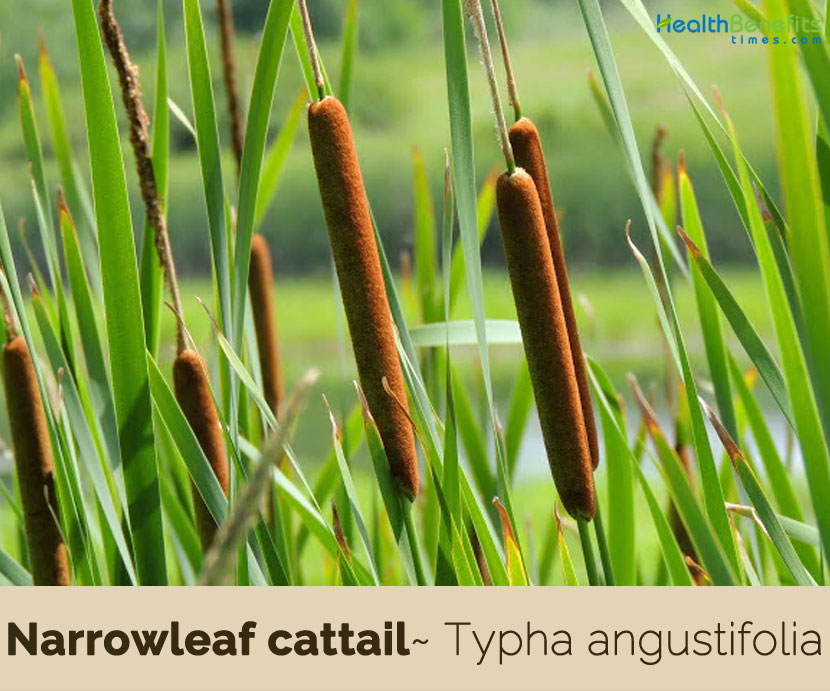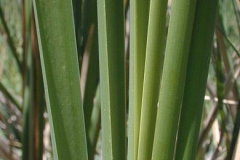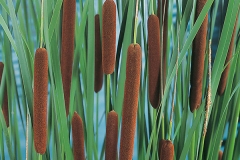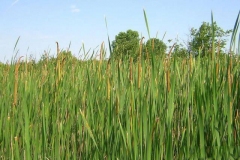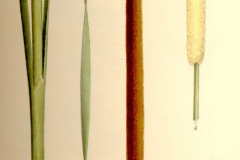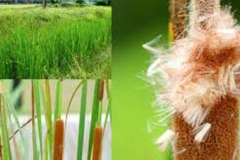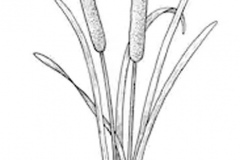| Narrowleaf cattail Quick Facts | |
|---|---|
| Name: | Narrowleaf cattail |
| Scientific Name: | Typha angustifolia |
| Origin | Nova Scotia south through parts of New England along the coast to southern Florida. It occurs in the Midwest south to southeastern Texas |
| Colors | Brown |
| Shapes | Dry, dehiscent, ellipsoid follicle with long hairs containing large numbers of small pendulous seeds, with a straight, narrow embryo |
| Taste | Sweet, acrid |
| Health benefits | Beneficial for kidney stones, painful menstruation, abnormal uterine bleeding, post-partum pains, cancer of the lymphatic system, tapeworms, diarrhea, stomach cramps,difficult urination, chronic colitis, hemorrhoids |
| Name | Narrowleaf cattail |
|---|---|
| Scientific Name | Typha angustifolia |
| Native | Nova Scotia south through parts of New England along the coast to southern Florida. It occurs in the Midwest south to southeastern Texas |
| Common Names | Cattail, Lesser Bulrush, Lesser Reed-Mace, Nail- Rod, Narrow-Leaf Cattail, Narrowleaf Cattail, Reed-Mace, Small Reed-Mace, Small Bulrush, Cumbungi |
| Name in Other Languages | Albanian: Shavar, shavari gjethengushtë Arabic : Bardî, Bût, Hhafâ’ Argentina : Totora Armenian: Keron neghaterev (Կերոն նեղատերև) Australia : Cumbungi Basque: Lezka hostoestu Belgium : Kleine Lisdodde Brazil : Taboa Bulgarian: Tesnolisten papur (теснолистен папур) Catalan: Balca, Balca de fulla estreta, Boga de fulla estreta, Bova, Bova de cadires, Ciri, Coets, Espadanya, Fusel Chinese: Shui zhu (水燭), Pu Huang Colombia : Enea Corsican: Burra cascistretta Croatian: Uskolisni rogoz Czech: Orobincem uzkolistym, Orobinec úzkolisty Danish: Smalbladet Dunhammer, Kleine rietsigaar, fijne lisdodde, kleine lisdodde, kleinste lisdodde Dominican Republic : Enea Dutch: Kleine lisdodde English: Cattail, Lesser bulrush, Lesser reed-mace, Lesser-bulrush, Nailrod, Narrow-leaf cat-tail, Small reed-mace, Narrow-leaved cattail, Cumbungi, Small bulrush Esperanto : Tifao Malgranda, Tifao Mallarĝfolia Estonian : Ahtalehine Hundinui Fiji : Deniruve, Denisoqe Finnish : Kapeaosmankäämi, Kapealehtinen Osmankäämi, Osmankaeaemi French : Chandelle, Massette À Feuilles Étroites, Massette Des Étangs, Quenouilles, Quenouille À Feuilles Étroites, Typha à feuilles étroites Gaelic : Coigeal Chaol German : Schmalblättriger Rohrkolben, Schmaler Rohrkolben Greek: Vrakteiofóro psathí (βρακτειοφόρο ψαθί) Gujarati: Ghābājarīyu (ઘાબાજરીયુ) Hebrew: Suf tzar-‘alim, סוּף צַר-עָלִים Hindi: Era, gon, paan, parocito, pata, patar, pater, patera, pota Hungarian: Keskenylevelű gyékény India : Hogla, Pater Indonesia : Purun, Lembang Italian : Lisca A Foglie Strette, Mazza Sorda, Schianze, Stiancia Minore, Tifa A Foglie Strette Japanese : Hime Gama, Himegama , Hosobahimegama (ホソバヒメガマ) Kannada: Aane jondu, aanejondu, apu, jambu, jambu hullu, mungusibaala, naribaala Latvian: Saurlapu vilkvālīte Lithuanian: Siauralapis švendras Manx: Bossan Malaysia : Banat Malayalam: Aattudharbapullu, Chambu, Aanapullu, Champu, Payapullu Marathi: Pan-kanis, pun, motitrina, tambana Nepalese : Khar, Pater Netherlands: Kleine Lisdodde Norwegian : Smal Dunkjevle, Smalbladet Dunkjevle, Smalt Dunkjevle Occitan: Filouso, Paviho negro Philippines : Homay-homay, Lampakanay, Tubal-tubal, Kaidked, Balangot, Balangot Polish : Pałka Wąskolistna, Rogóżka Portuguese : Tabua-Estreita, Tabôa, capim-de-esteira, erva-de-esteira, espadana, landim, paina-de-flexa, paineira-de-fleza, paineira-do-brejo, partasana, pau-de-lagoa, Tabebuia, tabua Romanian: Papură îngustă Russian : Rogoz Uzkolistnyj (Рогоз узколистный) Sanskrit: Eraka, gundra, gundramula, sari, sivi, erakasaktuh Serbian: Uskolisni rogoz, тврди рогоз, усколисни рогоз Slovak: Pálka úzkolistá Slovene: Ozkolistni rogoz Slovascina : Rogoz Ozkolistni Spanish : Acena, Anea, Espadaña, Espadaña Común, Espadaña Estrecha, Espadona, Junco De La Pasion, Macio De Hoja Estrecha, Mazio, Paja De Estera, Paja De Sillas, Totora, Tutuvaco, Vato, suca, Swedish : Smalkaveldum, Kapeaosmankäämi Tamil: Sambu Telugu: Dabbu jambu, dabbujambu, jambu, jammu, neeti jambu, jammugaddi Thailand : Kok Chaang, Thoup Susi, Kkcĥāng (กกช้าง), Kkṭhūp (กกธูป), Ṭhūpvɨs̄ʹī (ธูปฤๅษี), Prụ̄x (ปรือ), H̄ỵ̂ā s̄lāb h̄lwng, feụ̄̂x (หญ้าสลาบหลวง, เฟื้อ) Tibetan: Ku ntha Turkish : Su Kam1sh, saz Ukrainian: Rohiz vuzʹkolystyy (Рогіз вузьколистий), rohiz yamchastyy (рогіз ямчастий) Urdu: Bikh patera Uruguay : Totora Venezuela : Enea Vietnam : Bồn Bồn, Cỏ Nến, Thủy Hương, Hương bồ lá hẹp Welsh : Cynffon Y Gath Culddail, Cynffon Y Gath Leiaf, Ffon Y Plant, Ffynwewyr Ellyllon, Ffynwewyr Y Plant, Hesgen Felfedog, Hesgen Felfedog Goraidd, Hesgen Felfedog Leiaf, Rhodell, Rholbren,Tapr Y Dŵr Western Frisian: Lytse Tuorrebout |
| Plant Growth Habit | Erect, slender, marginal, rhizomatous, herbaceous, perennial semi aquatic emergent herb |
| Growing Climates | Grows in shallow fresh water of lakes, rivers, ponds, marshes, wet meadows, estuaries, bogs, ditches in valley marshes, coastal sites at low elevation, oxbow lakes, navigation canals, and natural freshwater and wetland systems (topogenous and soligenous mires, fens) |
| Soil | Occurs in peaty soils of salt marshes and colonizes deep sloughs and sloping marsh perimeters |
| Plant Size | About 3 to 6 feet (1-2 m) tall |
| Root | Sturdy, rhizomatous roots that can extend 27 inches and are typically ¾-1½ inches in diameter |
| Stem | Unbranched and cylindrical, 100–200 cm, with long (60–100 cm), linear, narrow leaves, 5–10 mm wide and deep green |
| Leaf | Plano-concave or plano-convex or strongly convex on the back, numbering <10 per stem, sheathing at the base and commonly overtopping the inflorescence |
| Flowering season | June to July |
| Flower | Monoecious (male and female flowers are produced on the same spike), with the male and female parts of each flower spike being separated by a gap of 1/ 2 to 3 inches. |
| Fruit Shape & Size | Dry, dehiscent, ellipsoid follicle with long hairs containing large numbers of small pendulous seeds, with a straight, narrow embryo |
| Fruit Color | Brown |
| Propagation | By seed and rhizomes |
| Plant Parts used | Pollen, Rhizome, root |
| Seed | Dry straw-colored and surrounded by the pistillate hair |
| Taste | Sweet, acrid |
| Precautions | Avoid use during Pregnancy. |
Plant Description
Narrowleaf cattail is an erect, slender, marginal, rhizomatous, herbaceous, perennial semi aquatic emergent herb that normally grows about 3 to 6 feet (1-2 m) tall, often forming, over time, dense stands of robust spreading vegetation. The plant is found growing in shallow fresh water of lakes, rivers, ponds, marshes, wet meadows, estuaries, bogs, ditches in valley marshes, coastal sites at low elevation, oxbow lakes, navigation canals, and natural freshwater and wetland systems (topogenous and soligenous mires, fens). The plant occurs in peaty soils of salt marshes and colonizes deep sloughs and sloping marsh perimeters. The plant has sturdy, rhizomatous roots that can extend 27 inches and are typically ¾-1½ inches in diameter.
Stems
Stems are erect and range from 3 to 9 feet high. Just below the inflorescence the stem of T. angustifolia is 2 to 3 mm thick. The middle stem section of T. angustifolia is only 5 – 12 mm thick.
Leaves
T. angustifolia has narrower leaves of up to 1/2 inch wide, rounded and thicker on the back side and the tops of leaf sheaths have membranous auricles. Leaves are attached near the base of the stem and overlap each other at the attachment points. Leaves are plano-concave or plano-convex or strongly convex on the back, numbering <10 per stem, sheathing at the base and commonly overtopping the inflorescence. Leaves are not edible but may be woven into mats, seats and baskets.
Flower
Flowers are monoecious (male and female flowers are produced on the same spike), with the male and female parts of each flower spike being separated by a gap of 1/ 2 to 3 inches. Slender upper spike has male flowers only with these flowers being shed soon after pollination. The lower spike has female flowers only, green when young but maturing to brown. After bloom, the male flowers rapidly disperse, leaving a naked stalk tip.
Fruit
The pollinated female flowers turn brown as the seeds mature, forming the familiar cylindrical, sausage-like, cattail fruiting spike (to 9 inches long in this species). This plant produces a phenomenal amount of seed (to 200,000 seeds per spike). Male flower spikes die and drop off, leaving the familiar brown female spike or cat tail that progressively dries and falls apart with its seed clumps scattering to the wind. Feather-like plumes of tiny brown hairs attached to each seed aid in this dispersal.
Traditional uses and benefits of Narrowleaf cattail
- In India, the species is used as a refrigerant, an aphrodisiac and a cure for dysuria.
- Typha angustifolia is mainly used in folk remedies for the treatment of tumors, as anticoagulant, astringent, sedative and tonics.
- Whole inflorescence is used in the healing of wounds.
- Stamens (without the pollen) are used in China as an astringent for dysentery and for hemorrhage of the bowels.
- The stamens, with the pollen, are also used as an astringent and styptic.
- Pollen was used as substitute for powder of licopodio and that the hairs or seeds were used against burns.
- The pollen is diuretic, emmenogogue and hemostatic.
- Dried pollen is said to be anticoagulant, but when roasted with charcoal it becomes hemostatic.
- It is used internally in the treatment of kidney stones, internal hemorrhage of almost any kind, painful menstruation, abnormal uterine bleeding, postpartum pains, abscesses and cancer of the lymphatic system.
- Externally, it is used in the treatment of tapeworms, diarrhea and injuries.
- In North America, the Malecite and Mimac tribes used the roots for treatment of kidney stones.
- Decoction of the root in the treatment of venereal diseases and the Xosas use it to aid in the expulsion of placenta.
- angustifolia was listed one of several traditional Chinese medicinal herbs used for the treatment of dysmenorrhea through the use of combination-herbal-formula therapeutics with minimal side effects.
- Pollen of Typha angustifolia has been used traditionally for the treatment of dysmenorrhea, stranguria and metrorrhagia in China.
- An infusion of the root has been used in the treatment of gravel.
- Tea of roots and leaves used for stomach cramps.
- In Chinese medicine, used for angina, brain clots, high lipids, difficult urination, chronic colitis, hemorrhoids, boils, rash in infants.
- In South Africa used to treat male fertility problems.
Culinary Uses
- Several parts of the plant are edible, including dormant sprouts on the roots and bases of the leaves, ripe pollen, the stem and the starchy roots.
- Roots can be consumed raw or cooked.
- They can be boiled and eaten like potatoes or macerated and then boiled to yield sweet syrup.
- Roots can also be dried, ground into a powder and then used as a thickener in soups, etc. or added to cereal flours, and this protein rich powder is used to make biscuits, etc.
- Young shoots are eaten in spring raw or cooked.
- The base of the mature stem is also edible raw or cooked.
- The tender, young flowering stem is also edible raw, cooked or prepare into a soup.
- The pollen is edible raw, cooked or processed into a protein rich additive to flour used in making bread, porridge, etc.
- Small seed is edible roasted or cooked and edible oil can be obtained from the seed.
- They can be boiled and eaten like potatoes or macerated and then boiled to yield sweet syrup.
- The roots can also be dried, ground into a powder and then used as a thickener in soups etc. or added to cereal flours.
- Rich in protein, this powder is used to make biscuits etc.
- It can also be eaten with the young flowers, which makes it considerably easier to utilize.
- The pollen can be harvested by placing the flowering stem over a wide but shallow container and then gently tapping the stem and brushing the pollen off with a fine brush.
- This will help to pollinate the plant and thus ensure that both pollen and seeds can be harvested.
- Core of young flower shoots are tender and can be eaten raw, with a taste of cucumbers.
- Green flower stems cooked on the stick and eaten like corn-on-a-cob.
Other Facts
- Plant is a good source of biomass, making a superior addition to the compost heap or used as a source of fuel, etc.
- The hairs of the fruits are used for stuffing pillows.
- They have good insulating and buoyancy properties.
- The female flowers make excellent tinder and can be lit from the spark of a flint.
- Stems and leaves have many uses, they make a good thatch, can be used in making paper, can be woven into mats, chairs, hats etc.
- The pollen is highly inflammable and is used in making fireworks.
- This plants extensive root system makes it very good for stabilizing wet banks of rivers, lakes etc.
- A single inflorescence can produce 20,000 to 700,000 small single-seeded fruits.
- T. angustifolia could be used for heavy metal phytoremediation from metal containing industrial wastewater.
References:
https://www.itis.gov/servlet/SingleRpt/SingleRpt?search_topic=TSN&search_value=42325#null
https://npgsweb.ars-grin.gov/gringlobal/taxonomydetail.aspx?id=40799
https://pfaf.org/user/plant.aspx?latinname=Typha+angustifolia
https://www.cabi.org/isc/datasheet/54294
http://www.missouribotanicalgarden.org/PlantFinder/PlantFinderDetails.aspx?taxonid=287386
http://www.floracatalana.net/typha-angustifolia-l-
https://plants.usda.gov/core/profile?symbol=TYAN
https://www.fs.fed.us/database/feis/plants/graminoid/typang/all.html
https://en.wikipedia.org/wiki/Typha_angustifolia
https://gd.eppo.int/taxon/TYHAN
http://www.theplantlist.org/tpl/record/kew-270931
https://indiabiodiversity.org/species/show/258733


